CHEVROLET KODIAK 2009 Owners Manual
Manufacturer: CHEVROLET, Model Year: 2009, Model line: KODIAK, Model: CHEVROLET KODIAK 2009Pages: 376, PDF Size: 5.39 MB
Page 101 of 376
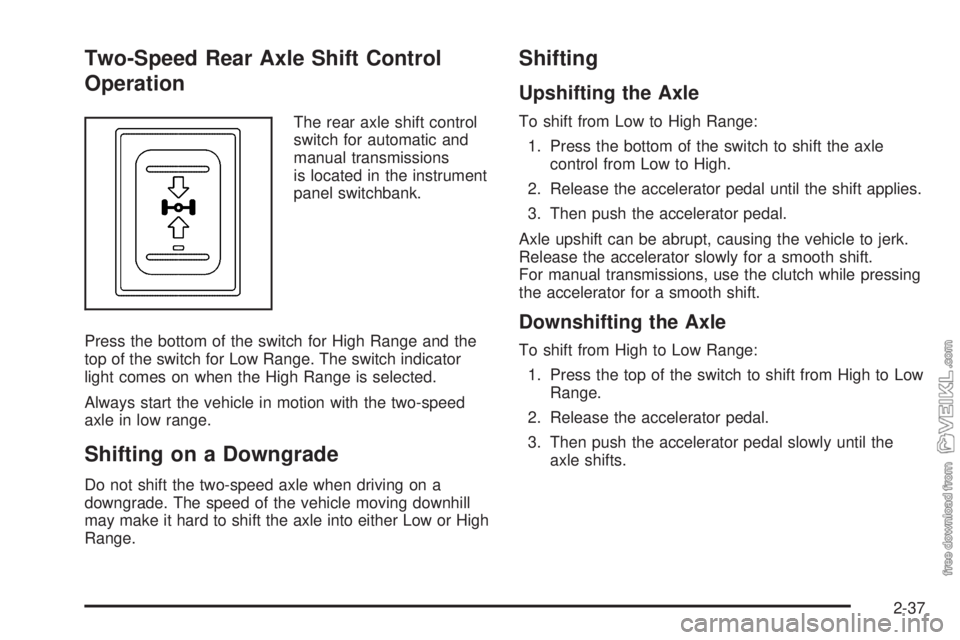
Two-Speed Rear Axle Shift Control
Operation
The rear axle shift control
switch for automatic and
manual transmissions
is located in the instrument
panel switchbank.
Press the bottom of the switch for High Range and the
top of the switch for Low Range. The switch indicator
light comes on when the High Range is selected.
Always start the vehicle in motion with the two-speed
axle in low range.
Shifting on a Downgrade
Do not shift the two-speed axle when driving on a
downgrade. The speed of the vehicle moving downhill
may make it hard to shift the axle into either Low or High
Range.
Shifting
Upshifting the Axle
To shift from Low to High Range:
1. Press the bottom of the switch to shift the axle
control from Low to High.
2. Release the accelerator pedal until the shift applies.
3. Then push the accelerator pedal.
Axle upshift can be abrupt, causing the vehicle to jerk.
Release the accelerator slowly for a smooth shift.
For manual transmissions, use the clutch while pressing
the accelerator for a smooth shift.
Downshifting the Axle
To shift from High to Low Range:
1. Press the top of the switch to shift from High to Low
Range.
2. Release the accelerator pedal.
3. Then push the accelerator pedal slowly until the
axle shifts.
2-37
Page 102 of 376
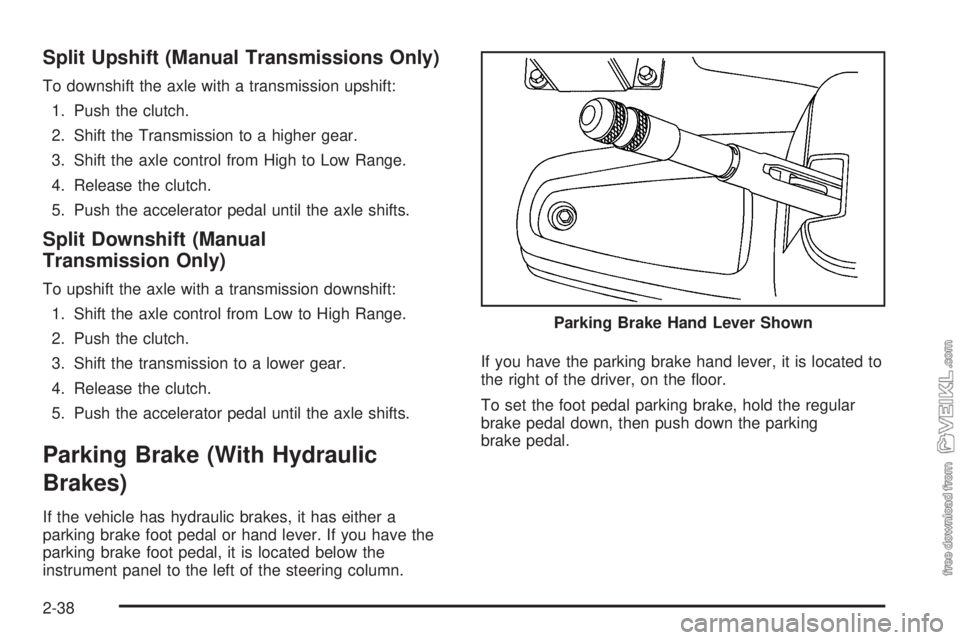
Split Upshift (Manual Transmissions Only)
To downshift the axle with a transmission upshift:
1. Push the clutch.
2. Shift the Transmission to a higher gear.
3. Shift the axle control from High to Low Range.
4. Release the clutch.
5. Push the accelerator pedal until the axle shifts.
Split Downshift (Manual
Transmission Only)
To upshift the axle with a transmission downshift:
1. Shift the axle control from Low to High Range.
2. Push the clutch.
3. Shift the transmission to a lower gear.
4. Release the clutch.
5. Push the accelerator pedal until the axle shifts.
Parking Brake (With Hydraulic
Brakes)
If the vehicle has hydraulic brakes, it has either a
parking brake foot pedal or hand lever. If you have the
parking brake foot pedal, it is located below the
instrument panel to the left of the steering column.If you have the parking brake hand lever, it is located to
the right of the driver, on the floor.
To set the foot pedal parking brake, hold the regular
brake pedal down, then push down the parking
brake pedal.Parking Brake Hand Lever Shown
2-38
Page 103 of 376
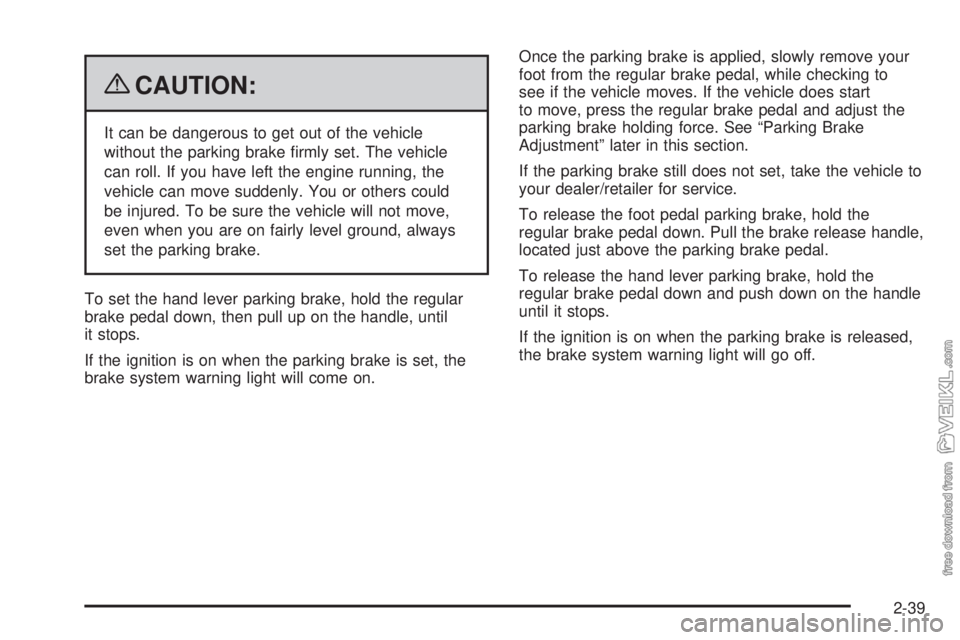
{CAUTION:
It can be dangerous to get out of the vehicle
without the parking brake firmly set. The vehicle
can roll. If you have left the engine running, the
vehicle can move suddenly. You or others could
be injured. To be sure the vehicle will not move,
even when you are on fairly level ground, always
set the parking brake.
To set the hand lever parking brake, hold the regular
brake pedal down, then pull up on the handle, until
it stops.
If the ignition is on when the parking brake is set, the
brake system warning light will come on.Once the parking brake is applied, slowly remove your
foot from the regular brake pedal, while checking to
see if the vehicle moves. If the vehicle does start
to move, press the regular brake pedal and adjust the
parking brake holding force. See “Parking Brake
Adjustment” later in this section.
If the parking brake still does not set, take the vehicle to
your dealer/retailer for service.
To release the foot pedal parking brake, hold the
regular brake pedal down. Pull the brake release handle,
located just above the parking brake pedal.
To release the hand lever parking brake, hold the
regular brake pedal down and push down on the handle
until it stops.
If the ignition is on when the parking brake is released,
the brake system warning light will go off.
2-39
Page 104 of 376
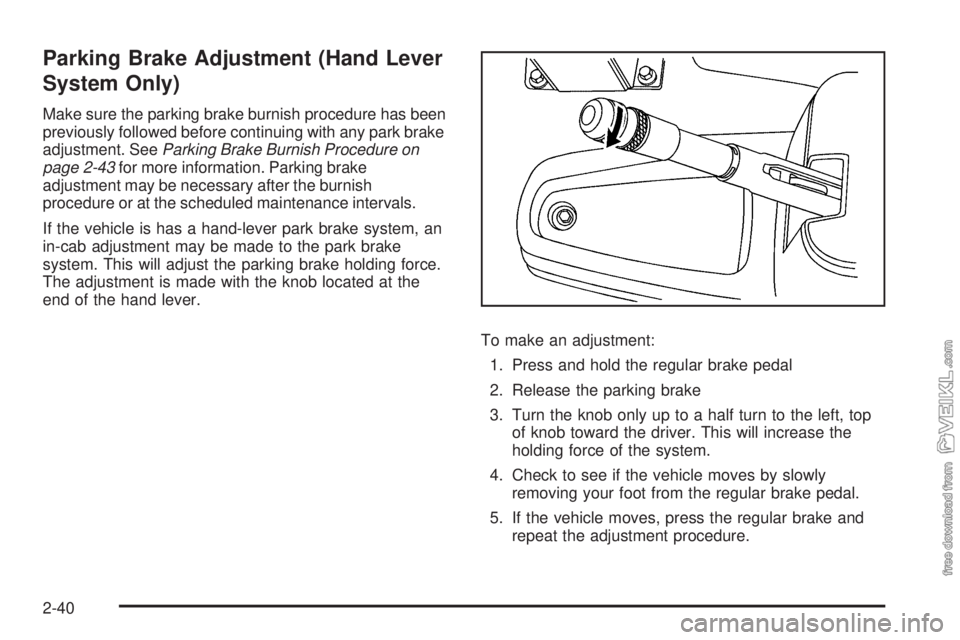
Parking Brake Adjustment (Hand Lever
System Only)
Make sure the parking brake burnish procedure has been
previously followed before continuing with any park brake
adjustment. SeeParking Brake Burnish Procedure on
page 2-43for more information. Parking brake
adjustment may be necessary after the burnish
procedure or at the scheduled maintenance intervals.
If the vehicle is has a hand-lever park brake system, an
in-cab adjustment may be made to the park brake
system. This will adjust the parking brake holding force.
The adjustment is made with the knob located at the
end of the hand lever.
To make an adjustment:
1. Press and hold the regular brake pedal
2. Release the parking brake
3. Turn the knob only up to a half turn to the left, top
of knob toward the driver. This will increase the
holding force of the system.
4. Check to see if the vehicle moves by slowly
removing your foot from the regular brake pedal.
5. If the vehicle moves, press the regular brake and
repeat the adjustment procedure.
2-40
Page 105 of 376
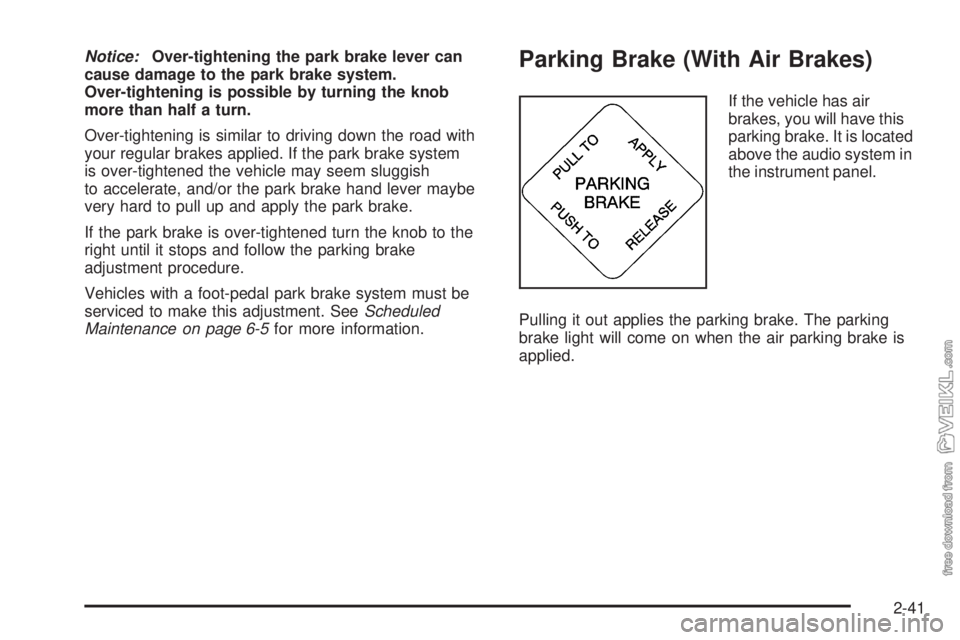
Notice:Over-tightening the park brake lever can
cause damage to the park brake system.
Over-tightening is possible by turning the knob
more than half a turn.
Over-tightening is similar to driving down the road with
your regular brakes applied. If the park brake system
is over-tightened the vehicle may seem sluggish
to accelerate, and/or the park brake hand lever maybe
very hard to pull up and apply the park brake.
If the park brake is over-tightened turn the knob to the
right until it stops and follow the parking brake
adjustment procedure.
Vehicles with a foot-pedal park brake system must be
serviced to make this adjustment. SeeScheduled
Maintenance on page 6-5for more information.Parking Brake (With Air Brakes)
If the vehicle has air
brakes, you will have this
parking brake. It is located
above the audio system in
the instrument panel.
Pulling it out applies the parking brake. The parking
brake light will come on when the air parking brake is
applied.
2-41
Page 106 of 376
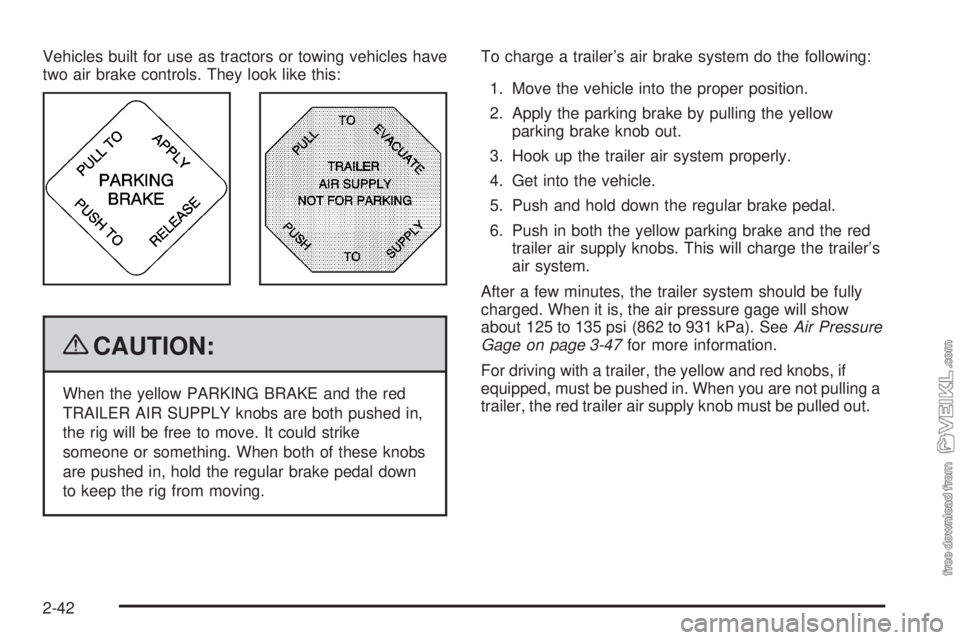
Vehicles built for use as tractors or towing vehicles have
two air brake controls. They look like this:
{CAUTION:
When the yellow PARKING BRAKE and the red
TRAILER AIR SUPPLY knobs are both pushed in,
the rig will be free to move. It could strike
someone or something. When both of these knobs
are pushed in, hold the regular brake pedal down
to keep the rig from moving.To charge a trailer’s air brake system do the following:
1. Move the vehicle into the proper position.
2. Apply the parking brake by pulling the yellow
parking brake knob out.
3. Hook up the trailer air system properly.
4. Get into the vehicle.
5. Push and hold down the regular brake pedal.
6. Push in both the yellow parking brake and the red
trailer air supply knobs. This will charge the trailer’s
air system.
After a few minutes, the trailer system should be fully
charged. When it is, the air pressure gage will show
about 125 to 135 psi (862 to 931 kPa). SeeAir Pressure
Gage on page 3-47for more information.
For driving with a trailer, the yellow and red knobs, if
equipped, must be pushed in. When you are not pulling a
trailer, the red trailer air supply knob must be pulled out.
2-42
Page 107 of 376
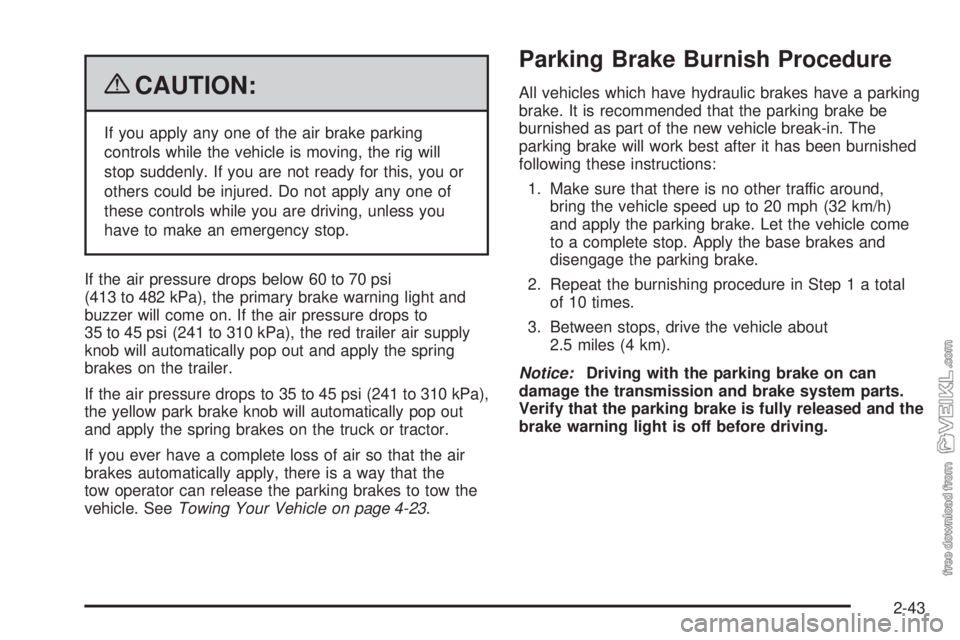
{CAUTION:
If you apply any one of the air brake parking
controls while the vehicle is moving, the rig will
stop suddenly. If you are not ready for this, you or
others could be injured. Do not apply any one of
these controls while you are driving, unless you
have to make an emergency stop.
If the air pressure drops below 60 to 70 psi
(413 to 482 kPa), the primary brake warning light and
buzzer will come on. If the air pressure drops to
35 to 45 psi (241 to 310 kPa), the red trailer air supply
knob will automatically pop out and apply the spring
brakes on the trailer.
If the air pressure drops to 35 to 45 psi (241 to 310 kPa),
the yellow park brake knob will automatically pop out
and apply the spring brakes on the truck or tractor.
If you ever have a complete loss of air so that the air
brakes automatically apply, there is a way that the
tow operator can release the parking brakes to tow the
vehicle. SeeTowing Your Vehicle on page 4-23.
Parking Brake Burnish Procedure
All vehicles which have hydraulic brakes have a parking
brake. It is recommended that the parking brake be
burnished as part of the new vehicle break-in. The
parking brake will work best after it has been burnished
following these instructions:
1. Make sure that there is no other traffic around,
bring the vehicle speed up to 20 mph (32 km/h)
and apply the parking brake. Let the vehicle come
to a complete stop. Apply the base brakes and
disengage the parking brake.
2. Repeat the burnishing procedure in Step 1 a total
of 10 times.
3. Between stops, drive the vehicle about
2.5 miles (4 km).
Notice:Driving with the parking brake on can
damage the transmission and brake system parts.
Verify that the parking brake is fully released and the
brake warning light is off before driving.
2-43
Page 108 of 376
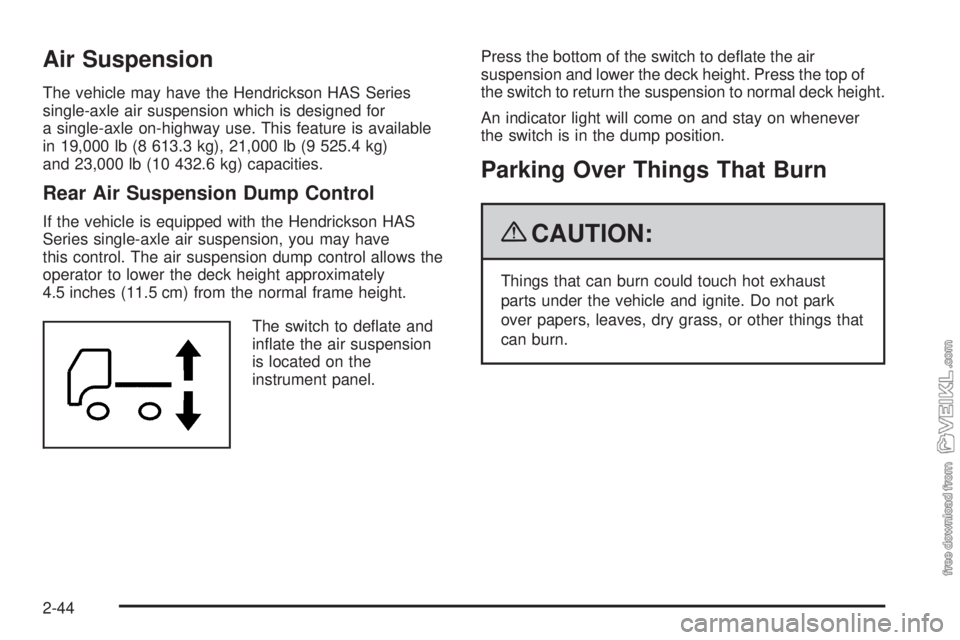
Air Suspension
The vehicle may have the Hendrickson HAS Series
single-axle air suspension which is designed for
a single-axle on-highway use. This feature is available
in 19,000 lb (8 613.3 kg), 21,000 lb (9 525.4 kg)
and 23,000 lb (10 432.6 kg) capacities.
Rear Air Suspension Dump Control
If the vehicle is equipped with the Hendrickson HAS
Series single-axle air suspension, you may have
this control. The air suspension dump control allows the
operator to lower the deck height approximately
4.5 inches (11.5 cm) from the normal frame height.
The switch to deflate and
inflate the air suspension
is located on the
instrument panel.Press the bottom of the switch to deflate the air
suspension and lower the deck height. Press the top of
the switch to return the suspension to normal deck height.
An indicator light will come on and stay on whenever
the switch is in the dump position.
Parking Over Things That Burn
{CAUTION:
Things that can burn could touch hot exhaust
parts under the vehicle and ignite. Do not park
over papers, leaves, dry grass, or other things that
can burn.
2-44
Page 109 of 376
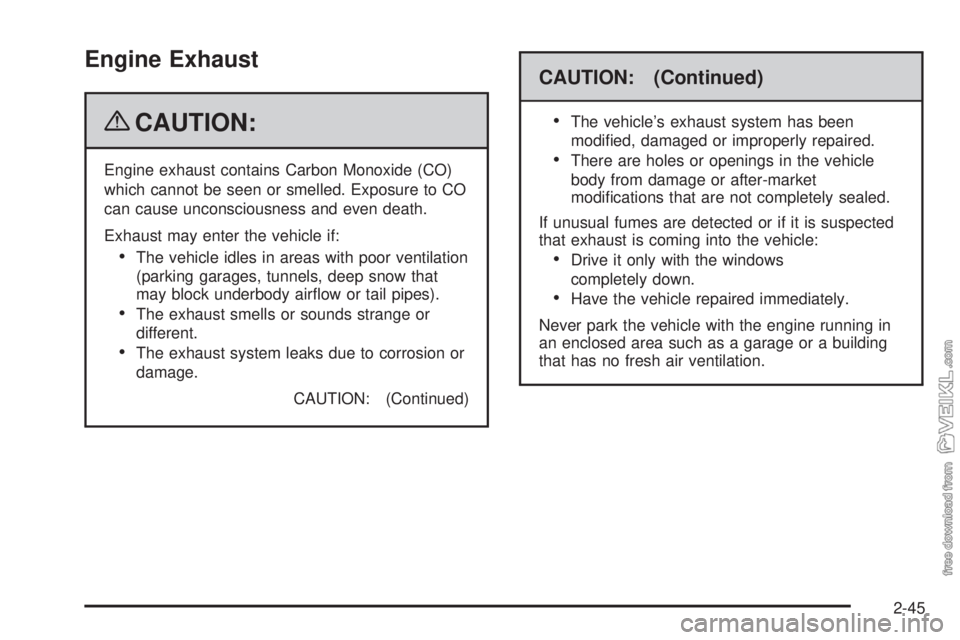
Engine Exhaust
{CAUTION:
Engine exhaust contains Carbon Monoxide (CO)
which cannot be seen or smelled. Exposure to CO
can cause unconsciousness and even death.
Exhaust may enter the vehicle if:
•The vehicle idles in areas with poor ventilation
(parking garages, tunnels, deep snow that
may block underbody airflow or tail pipes).
•The exhaust smells or sounds strange or
different.
•The exhaust system leaks due to corrosion or
damage.
CAUTION: (Continued)
CAUTION: (Continued)
•
The vehicle’s exhaust system has been
modified, damaged or improperly repaired.
•There are holes or openings in the vehicle
body from damage or after-market
modifications that are not completely sealed.
If unusual fumes are detected or if it is suspected
that exhaust is coming into the vehicle:
•Drive it only with the windows
completely down.
•Have the vehicle repaired immediately.
Never park the vehicle with the engine running in
an enclosed area such as a garage or a building
that has no fresh air ventilation.
2-45
Page 110 of 376
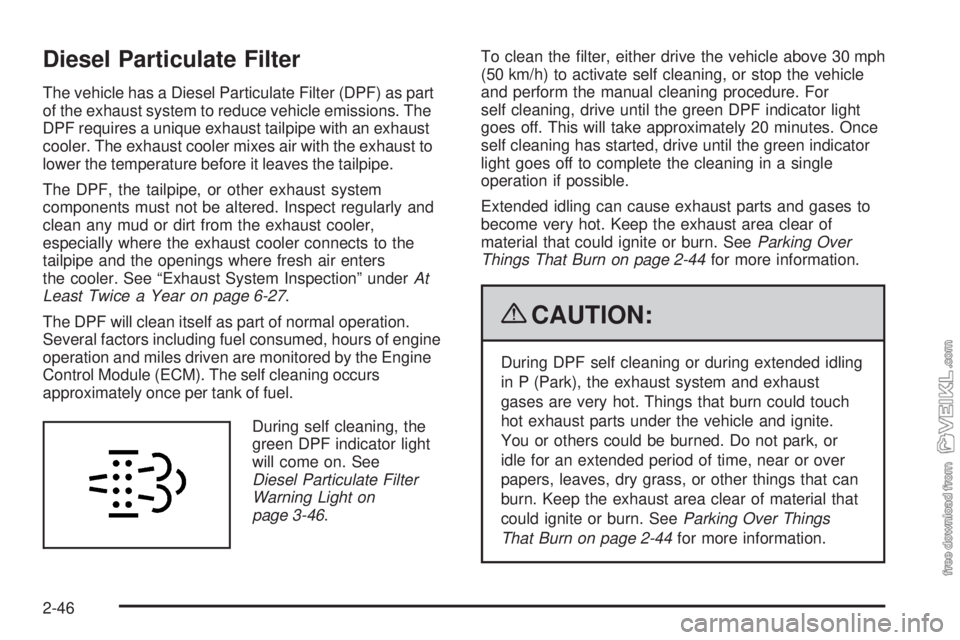
Diesel Particulate Filter
The vehicle has a Diesel Particulate Filter (DPF) as part
of the exhaust system to reduce vehicle emissions. The
DPF requires a unique exhaust tailpipe with an exhaust
cooler. The exhaust cooler mixes air with the exhaust to
lower the temperature before it leaves the tailpipe.
The DPF, the tailpipe, or other exhaust system
components must not be altered. Inspect regularly and
clean any mud or dirt from the exhaust cooler,
especially where the exhaust cooler connects to the
tailpipe and the openings where fresh air enters
the cooler. See “Exhaust System Inspection” underAt
Least Twice a Year on page 6-27.
The DPF will clean itself as part of normal operation.
Several factors including fuel consumed, hours of engine
operation and miles driven are monitored by the Engine
Control Module (ECM). The self cleaning occurs
approximately once per tank of fuel.
During self cleaning, the
green DPF indicator light
will come on. See
Diesel Particulate Filter
Warning Light on
page 3-46.To clean the filter, either drive the vehicle above 30 mph
(50 km/h) to activate self cleaning, or stop the vehicle
and perform the manual cleaning procedure. For
self cleaning, drive until the green DPF indicator light
goes off. This will take approximately 20 minutes. Once
self cleaning has started, drive until the green indicator
light goes off to complete the cleaning in a single
operation if possible.
Extended idling can cause exhaust parts and gases to
become very hot. Keep the exhaust area clear of
material that could ignite or burn. SeeParking Over
Things That Burn on page 2-44for more information.
{CAUTION:
During DPF self cleaning or during extended idling
in P (Park), the exhaust system and exhaust
gases are very hot. Things that burn could touch
hot exhaust parts under the vehicle and ignite.
You or others could be burned. Do not park, or
idle for an extended period of time, near or over
papers, leaves, dry grass, or other things that can
burn. Keep the exhaust area clear of material that
could ignite or burn. SeeParking Over Things
That Burn on page 2-44for more information.
2-46